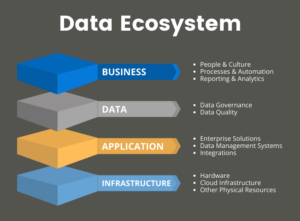5 Ways to Prepare Your Nonprofit for a Data-Driven Future

Liz Murray
Director, Data Ecosystem Consulting
What comes to mind when you think about the future of data for nonprofits? Management of constituent information? Robust reporting systems? Heightened security? Integration of AI? It’s clear that the industry will continue to see exponential growth of data and its capabilities.
Your nonprofit will have a lot to consider as it advances toward this data-driven future. So, what can you do to prepare? Here are five steps your nonprofit can take to position itself for success.
1) Understand Where You Are Today
The old adage rings true: To get where you’re going, you need to know where you’re starting from. Think holistically about your data ecosystem, considering and understanding each unique layer. These layers are:
- Business: people and culture, business processes, and reporting & analytics
- Data: data governance and data quality
- Application: enterprise solutions like your CRM, data management systems (like a data lake or warehouse) and data integrations
- Infrastructure: hardware and other physical resources

You’ll need to understand each layer, its components, and how they interact as an interconnected system in order to effectively respond and make changes. Read more about each layer in this article.
2) Know Where You Want to Go
Once you understand your current state, it’s time to look to the future. Capture and leverage stakeholder input to develop an organization-wide vision. It’s important that all staff are on the same page and that you have full buy-in as you move forward.
You’ll also need to align your strategy with technology and operations to achieve your vision. You’ll want to address current pain points, critical new functionality, and ways to improve data governance and quality.
Hot Tip: Start by envisioning your ideal state. Don’t worry, there will be a time and a place for discussing realities down the line. Envisioning your desired state will help you think about the possibilities. From there, you can iterate until you arrive at your final future state.
3) Prioritize
Now that you know where you want to go, you can take your first steps. It’s time to put your project management hat on and evaluate your potential future state work log to decide what to do first.
This is where you’ll need to think about tradeoffs and the impact of each item. Be sure to consider:
- Impact on Stakeholders: Will the change result in a positive experience for your constituents, both internal and external?
- Increased Revenue – Will it bring in more gifts?
- Operational Efficiency – Will it optimize processes?
- New Functionality – Does it add new critical functionality to help you compete?
- Risk Management – Will it reduce potential threats?
- Strategic Alignment – Does it align with your overall strategy?
As you complete this exercise, you may decide to put some of the items in a backlog, as the impact may not be worth your efforts just yet.
Prioritization is essential to make the most of your finite resources and see measurable results from your investments.
4) Develop a Roadmap
After you’ve set your organizational priorities, you need to explore how you’re going to get to your future state. It’s time to develop a roadmap.
Your roadmap should be inclusive of projects and initiatives that will improve your data, operations, and technology. Examples include selecting and implementing new technology, hiring additional staff, or launching a data governance working group.
The roadmap should support planning and budgeting, provide focus, and help your organization effectively build capacity.
How long should a roadmap cover? We recommend aiming for a 2–3-year timespan. Anything longer gets a little fuzzy, and planning isn’t as productive. A lot can change in 2-3 years, and you will learn from your experiences. Read this article to learn more about creating a technology roadmap.
Hot Tip: Review your roadmap annually. Remember, the roadmap is a living, changing document. As part of the annual checkup, you can look at what you’ve achieved, what you learned, and what you plan to work on next and adjust as needed.
5) Measure Impact
After you’ve completed the first four steps, you need to measure their impact. You want to ensure that you are seeing the intended business gains you set out to achieve. Create Key Performance Indicators (KPIs) that align with your roadmap.
Measuring impact could be tricky at first, as you might not have baseline metrics to effectively compare your “before” to your “after.” Don’t let that stop you! Instead, think incrementally and improve your organization’s ability to measure as part of the roadmap.
Hot Tip: Leverage your metrics to build the case for support. Your roadmap is a long-term investment, and you’ll need to show progress and demonstrate value along the way.
Make the most out of your budget and utilize KPIs to report back to funders, donors, and other key stakeholders.
Embracing Technology and Strategic Planning
As we look into the future of data for nonprofits, it’s no surprise that embracing technological advancements and strategic planning are imperative.
By following these steps, your nonprofit will be better prepared to navigate the complexities of the data-driven future with confidence and agility.
Your Partner in Progress
For over 30 years, JCA has fused technology expertise and real-world experience to create breakthrough outcomes for nonprofits.
Let us be your partner in progress, working with you on everything from evaluating your infrastructure and identifying improvement areas to creating your technology roadmap and implementing new systems.
